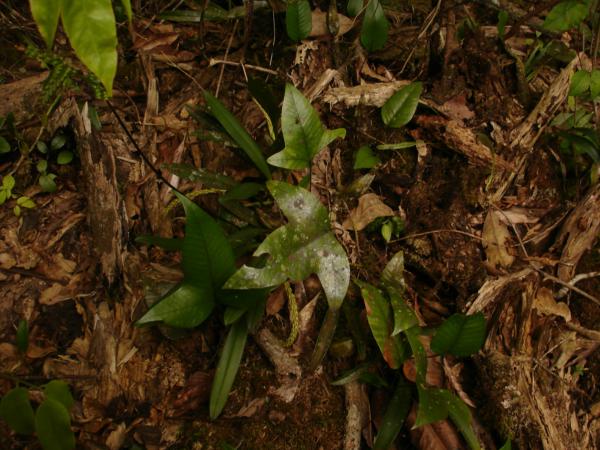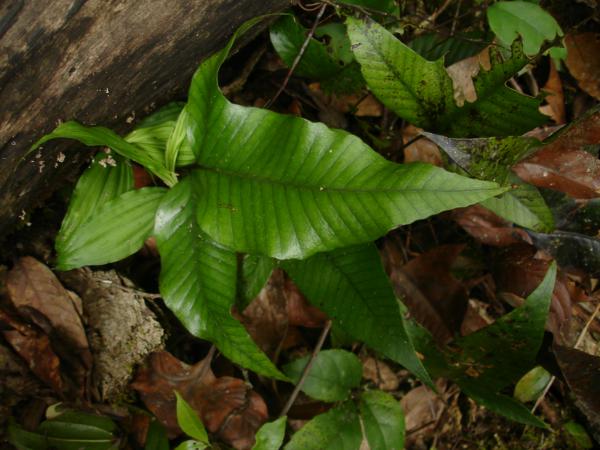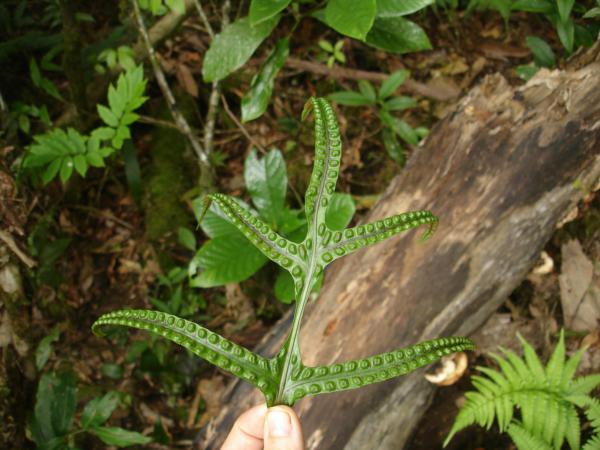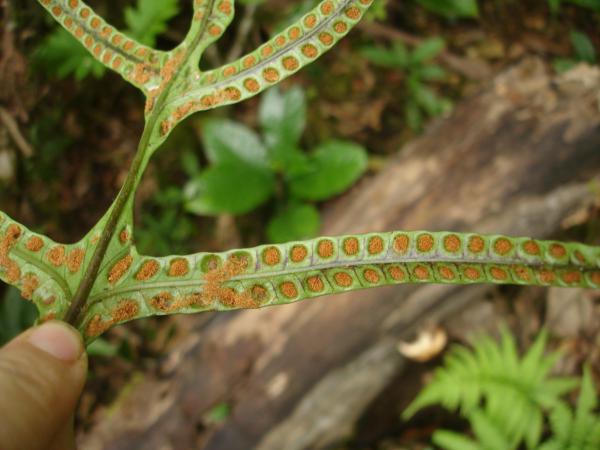
Selliguea triloba (Houtt.) M.G.Price
Family
Polypodiaceae
Nomenclature
Selliguea triloba (Houtt.) M.G.Price, Contr. Univ. Mich. Herb. 17: 276. 1990; Hovenkamp, Fl. Males., Ser. II, Ferns and Fern Allies 3: 228. 1998. – Polypodium trilobum Houtt., Hist. Nat.: 14. 1783. – Phymatodes triloba (Houtt.) Ching, Bull. Fan. Mem. Inst. Biol. 1: 239. 1941. – Crypsinus trilobus (Houtt.) Copel., Gen. Fil.: 206. 1947; Holttum, Rev. Fl. Malaya ed. 1, 2: 197, f. 97. 1955 [‘1954’]; Tagawa & K.Iwats., SouthE. Asian Stud. 5: 60. 1967; Tagawa & K.Iwats., Acta Phytotax. Geobot. 23: 53. 1968; Tagawa & K.Iwats., Fl. Thailand 3: 558. 1989; Boonkerd & Pollawatn, Pterid. Thailand: 268. 2000. – Phymatopsis triloba (Houtt.) Ching, Acta Phytotax. Sin. 9: 194. 1964. – Phymatopteris triloba (Houtt.) Pic.-Serm., Webbia 2: 465. 1973. – Type: Thunberg s.n., Java.
Polypodium triphyllum Jacq., Coll. 2: 284, t. 22, f. 1. 1788. – Phymatodes triphylla (Jacq.) C.Chr. & Tardieu, Not. Syst. 2: 284, t. 22. 1941; C.Chr. & Tardieu, Fl. Indo-Chine 7(2): 470, f. 55, 4–5. 1941.
Polypodium incurvatum Blume, Enum. Pl. Javae.: 126. 1828. – Pleopeltis incurvata (Blume) T.Moore, Gard. Chron. 1860: 1105. 1860; Bedd., Handb. Ferns Brit. India: 364, f. 206. 1883. – Phymatopsis incurvatum (Blume) J.Sm., Hist. Fil.: 105. 1875.
Description
Rhizome long creeping, 3–6 mm diam., not so densely scaly throughout; scales peltate, ovate, more or less imbricate, acuminate but not tailed at apex, rounded at base, 3–6 by 1.2–1.5(–1.8) mm, pale brown with a paler margin, membranous, subentire to short dentate at margin. Fronds distinctly dimorphic. Sterile fronds: stipes 7–17(–40) cm long, stramineous or dark purple, scaly on phyllopodia up to 4 mm in height, glabrescent upwards; laminae usually trilobed, rarely simple or pinnatifid (5-lobed or 7-lobed); simple laminae subdeltoid, round at base, gradually narrowing towards moderately acute apex, 6–10(–33) by 4.1–8.8 cm; lobed laminae 10–20 by 13–25 cm, apical lobes like simple laminae, lateral lobes oblong to oblong-lanceolate, ascending, more or less falcate, caudately acuminate at apex, slightly narrowing at base in large ones, 4.5–12(–21) by 2.3–4.5(–5.5) cm; rachis and costae distinctly raised beneath, main veins distinct on both surfaces, other veins hardly visible, anastomosing, areoles with included free veinlets; coriaceous, light green. Fertile fronds taller: stipes (14–)25–35(–50) cm long; laminae tri-lobed to pinnatisect or pinnate with 3–4(–7) pairs of lateral lobes (or pinnae); rachis narrowly winged by the wings less than 5 mm in breadth, or wingless in lower parts; lobes (or pinnae) linear, acuminate at apex, entire, 7–14(–18) by 0.7–0.8(–1.3) cm, the basal ones the largest, smaller upwards. Sori in a single row at each side of costa, embedded in deep rounded or oblong cavities up to 5 mm diam. and 2 mm in depth, prominently raised on upper surface.
Distribution in Thailand
PENINSULAR: Nakhon Si Thammarat, Yala.
Distribution in Laos
Salavan.
Distribution in Cambodia
Kampot.
Wider Distribution
China (Hainan), Indochina, Peninsular Malaysia, Sumatra, Java, Borneo, Philippines, Moluccas.
Ecology
On mossy trunks of fallen trees in clearing on ridges at medium or high altitudes.
Proposed IUCN Conservation Assessment
Least Concern (LC). This species is widespread and not under any known threat.
Habit
Upper surface of sterile frond
Upper surface of fertile frond
Lower surface of fertile frond
Site hosted by the Royal Botanic Garden Edinburgh. Content managed by Stuart Lindsay, Gardens by the Bay, Singapore and David Middleton, Singapore Botanic Gardens. Last updated 24 January 2012



